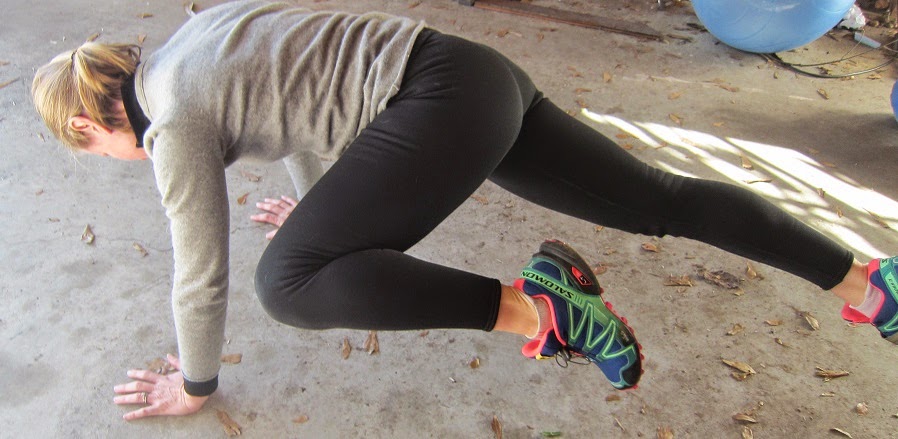Raised Platform (e.g. step, base of a slide, balance apparatus)
Step-ups
 |
| Keep your body upright . |
 Exercise: Face the platform with one foot on the ground and one on the platform. Keeping your knee over your heel, squeeze through the glute of the
Exercise: Face the platform with one foot on the ground and one on the platform. Keeping your knee over your heel, squeeze through the glute of theraised leg to bring your body to standing position on the platform. The moving leg will pull forward to the front of the body (see left) and come to balance, which will challenge your core. Stabilize, then, with control, lower to the starting position. Complete 10-15 on one leg and then switch to the other. Strive for 2-3 sets.
Adding to the challenge: As you get stronger, choose a higher platform, up to the safe max height described above, or at the starting position, you can bend the back leg and rise on to the ball of the foot to start the exercise from a lunge (see right).
Push-ups
 Skip the "girlie" push-up. The same platform can be used to assist in strengthening your body to do
Skip the "girlie" push-up. The same platform can be used to assist in strengthening your body to doa push-up on your toes. The lower the platform is, the harder the work.
Exercise: Place your hands on the platform. Walk your feet back to where you are standing on your toes and your hips are in line with your body, forming a straight line from the base of your skull to your heels. You shoulders should be directly over your wrists. Lower your body until a 90 degree bend is formed at your elbows and then push smoothly to the starting position. Find a platform sufficiently high to allow you to do 6-8 for beginners and 10-12 for those more advanced. Strive for 2-3 sets.
Build up to it: If you are already on the ground and knocking out push-ups from your toes, try placing your feet on the raised platform and hands on the ground.
Dips
 |
| Your chin should be level to help relax your shoulders away from your ears. |
Exercise: Sit on your hands with fingers bent over the edge of the platform. Shift your weight off the platform and move your hands closer so that they are directly behind your shoulders. The further your feet are from your body, the harder the work (a 90 degree bend at the knee will be less difficult than straight legs and resting on your heels). Lower your body to form a 90 degree bend (see right) with your elbow and then push to re-straighten the arm. Make sure that you feel the platform brush your back with each dip. Strive for 2-3 sets of 10-15.
Swing
Plank with Oblique Contraction
 |
| Maintain a strong plank throughout the move and ensure that your hips face the ground. |
Adding to the challenge: As you bring your knee to your shoulder, go down for a push-up.
Single-Leg Squat
Combine core stability with serious glute work in this highly effective squat.
Exercise: Stand a leg's length or less in front of the swing with your back to it. Lift leg behind you to rest your foot, laces down, on the swing. Keeping your chest up, slowly lower yourself on one leg, pushing your hips back, so that your knee does not go past your toe. At the base of the move, contract your glutes to return to standing with your foot still on the swing. Strive for 2-3 sets of 10-12 on each leg.
Build up to it: Make balance harder and force more work into the glute by lifting your toes and balancing on the heel.
Monkey Bars
Hanging Leg Lift
Put your shoulders under pressure while you work your lower abdominals.
Exercise: With arms extended overhead, grip the bar. Lift bent legs toward chest. Be careful not to use momentum. Strive for two sets of 8-10.
Making it more difficult: straighten legs during lift toward chest.
See-Saw
Plyometric See-Saw Squat
The see-saw is a great tool for squats because it naturally positions your legs, at near-shoulder width to bend in front of your body, while keeping your weight back. It is also great practice for learning how to control your landing. Grab your child for this one and get ready for a challenge. (Note: This move involves jumping; if you have never done plyometrics or jump training or have concerns, you should complete the move without your feet leaving the ground.)
Exercise: Squeezing your inner thigh to keep your knees forward, contract your glutes and push off the balls of your feet. When on your way back down, use your muscles to stop the see-saw with your legs at 90 degrees. Hold for a moment at the base of the move and then push off again; the seat should never touch the ground. Strive for 2-3 sets of 10-15 squats.
Adding to the challenge: Make the move harder for you and more interesting for your child by changing how hard you push off; the smaller and faster the rhythm, completed by only barely rising out of the 90 degree bend will keep your muscles under pressure and add to the burn.
Parents frequently disappear to the gym or on a run for their exercise, so kids never see mom and dad exercising. Working out in front of them sets a great example for being active and allows them to get involved, giving them positive associations with physical activity, if only because they got to do it with you.

